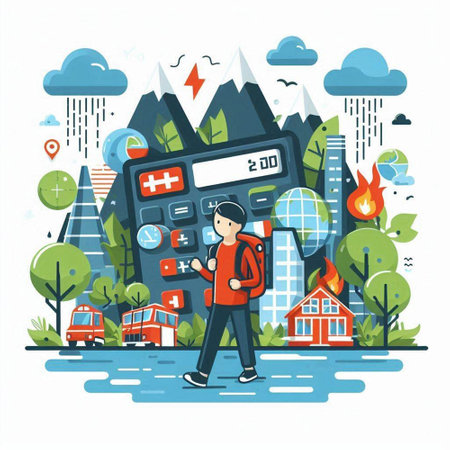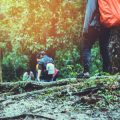Introduction: Tradition Meets Technology
Rambling has long been woven into the fabric of British culture, with clubs and societies dedicated to walking the countryside dating back over a century. These groups, rooted in a shared appreciation for the UKs diverse landscapes and a collective spirit of exploration, have traditionally relied on printed maps, word-of-mouth recommendations, and handwritten route notes passed between members. However, as digital technologies become ever more integral to daily life, even these time-honoured institutions are embracing change. Today, rambling clubs across the UK are finding innovative ways to blend their proud heritage with modern tools—reshaping not only how routes are planned and shared but also how communities connect and grow. This meeting of tradition and technology is redefining what it means to be a rambler in the twenty-first century.
Connecting Communities Online
In recent years, rambling clubs throughout the UK have embraced digital platforms to bring together walkers from all walks of life. By harnessing the power of social media, online forums, and dedicated walking apps, these groups are not only preserving traditional camaraderie but also reaching new members who may never have considered joining a walking club before. This digital shift has been instrumental in making rambling more accessible and appealing to a broader audience.
Social media platforms such as Facebook and Instagram have become vital for sharing walk schedules, event photos, and stories from the trail. These platforms allow both seasoned ramblers and newcomers to connect instantly, share advice, and arrange informal meetups. Online forums, often hosted on club websites or popular outdoor enthusiast sites, provide spaces for detailed discussions about routes, gear recommendations, and local wildlife sightings—helping foster a sense of community even outside of scheduled walks.
Dedicated walking apps further enhance this connectivity. Many clubs now use apps that offer route mapping, group messaging, and event registration features. These tools simplify organising group outings and tracking attendance while making it easier for members to discover new walks tailored to their interests and abilities.
| Digital Tool | Purpose | Community Impact |
|---|---|---|
| Social Media (Facebook Groups/Instagram) | Event promotion, photo sharing, instant updates | Expands reach and fosters real-time engagement |
| Online Forums | Discussion threads on routes, advice, logistics | Cultivates knowledge sharing and peer support |
| Walking Apps (e.g., Komoot, Meetup) | Route planning, group communication, RSVP management | Makes organising and joining walks more convenient |
This evolution towards digital networking has seen many clubs welcome younger members and those from diverse backgrounds. With these innovations, rambling clubs are ensuring that their traditions not only endure but thrive in a rapidly changing society. By creating welcoming digital spaces alongside physical trails, they continue to strengthen bonds within communities up and down the country.

3. Digital Route Planning and Navigation
The integration of GPS mapping tools and mobile applications has revolutionised the way rambling clubs approach route planning and navigation across the UK countryside. Traditionally, walkers relied on printed Ordnance Survey maps and compass skills, often poring over weathered paper in the field to decipher their path. Today, however, many clubs have embraced digital solutions such as OS Maps online, Komoot, or ViewRanger, making both planning and real-time navigation more efficient and accessible for all ages and abilities.
These digital innovations have significantly improved safety on walks. Walkers can now share live locations with group members or emergency contacts, receive instant weather updates, and adjust routes on-the-fly if footpaths are blocked or conditions change unexpectedly. For newcomers or less experienced ramblers, mobile apps lower the barrier to entry by providing clear visual cues and step-by-step guidance. This inclusive approach means that even those unfamiliar with traditional map reading can confidently join group outings.
However, the widespread use of GPS technology raises questions about the future of classic map reading skills—a core part of Britain’s walking culture. Some seasoned members express concerns that an over-reliance on smartphones may erode these traditional skills, which are invaluable in areas with poor signal or when devices fail. As a result, many clubs now blend the old with the new: while digital tools enhance efficiency and safety, regular training sessions still emphasise the importance of understanding physical maps and basic navigation techniques.
Ultimately, the adoption of digital route planning reflects a pragmatic balance between embracing innovation and preserving heritage. Rambling clubs are finding ways to ensure that technology serves as an aid—not a replacement—for the fundamental skills that have shaped generations of British walkers.
Preserving Local Heritage with Digital Archives
One of the most remarkable developments in the world of British rambling clubs is the use of digital technology to safeguard and celebrate local heritage. Walking has always been more than just a leisure activity; it is deeply entwined with history, stories, and folklore that paint a vivid picture of Britain’s countryside and communities. Rambling clubs are now embracing blogs, podcasts, and online photo albums to meticulously document these narratives, making them accessible for current members and future generations alike.
Blogging: Chronicling Walks and Wisdom
Blogs have become a mainstay for many clubs, offering detailed accounts of routes, personal reflections, and historical anecdotes tied to specific paths. These digital diaries not only help preserve collective memories but also encourage knowledge-sharing among walkers. Whether its recounting tales of old coaching inns or celebrating a club’s centenary, blogging serves as an invaluable record.
Podcasts: Bringing Stories to Life
Several rambling groups have started producing podcasts—an engaging way to share interviews with long-standing members, discuss local legends, or offer practical advice on walking etiquette. Podcasts make oral histories portable, allowing listeners to tune in during their own walks or commutes. This medium breathes new life into traditional storytelling and keeps the culture vibrant.
Photo Albums: Visual Storytelling Online
Online photo galleries hosted on club websites or social media platforms provide a visual journey through time. From snapshots of windswept fells to images of group celebrations at historic landmarks, these albums not only capture landscapes but also document the evolving identity of each club.
Overview of Digital Archiving Methods
| Method | Main Use | Benefits |
|---|---|---|
| Blogs | Documenting walks and sharing stories | Accessible records; encourages member participation |
| Podcasts | Oral histories and discussions | Engaging format; preserves voices and personalities |
| Photo Albums | Visual documentation of events/landscapes | Easily shared; builds community pride and nostalgia |
The Role of Community Contributions
Encouraging members to contribute their own blog posts, podcast segments, or photos ensures that the archive remains diverse and representative of the club’s collective experience. This grassroots approach fosters a strong sense of belonging while preserving local heritage in a dynamic, interactive way.
5. The Environmental Impact of Data
As rambling clubs across the UK embrace digital innovations, there is a growing recognition of the role that technology can play in monitoring and preserving our natural landscapes. The adoption of data-driven tools allows groups to keep a closer eye on footpath conditions, biodiversity, and environmental impact, making sustainable walking not just a concept, but a practical reality.
Monitoring Footpath Conditions
With the help of mobile apps and GPS tracking, ramblers are now able to record and report the state of footpaths in real time. This crowdsourced data feeds into larger mapping projects and local council databases, ensuring that issues such as erosion, overgrowth, or blockages are promptly addressed. As a result, clubs can work more efficiently with authorities to maintain access while minimising ecological disturbance.
Biodiversity Insights Through Citizen Science
Many rambling clubs have partnered with conservation organisations to encourage members to log wildlife sightings via dedicated apps. These contributions provide valuable insights into local biodiversity trends and help identify areas in need of protection or restoration. In turn, this fosters a greater sense of stewardship among walkers and supports national efforts like the Big Butterfly Count or RSPB’s birdwatch surveys.
Promoting Sustainable Practices
Technology is also proving invaluable in promoting sustainable walking habits. Digital resources offer guidance on responsible route planning—such as sticking to established trails or avoiding sensitive habitats during breeding seasons. Some apps even highlight public transport links to trailheads, reducing the reliance on cars and lowering the overall carbon footprint associated with group walks. Through these innovations, rambling clubs are not only adapting to the digital age but leading by example in championing environmental responsibility.
6. Challenges and Considerations
As rambling clubs across the UK embrace digital innovations, several challenges and considerations have surfaced that warrant careful attention. One of the most prominent concerns is digital exclusion. While many members appreciate the convenience of online maps, booking systems, and digital forums, not everyone feels equally confident with technology. Some older ramblers or those in rural areas may struggle with poor connectivity or lack of digital literacy, potentially leaving them at a disadvantage. Clubs must balance progress with inclusivity, perhaps by offering training sessions or maintaining some analogue options alongside their digital offerings.
Privacy is another important issue. The use of apps for tracking routes and sharing photos can inadvertently expose sensitive data about members’ locations and habits. It’s essential for clubs to establish clear guidelines around data sharing and ensure any platforms used comply with UK privacy regulations such as GDPR. Open discussions within committees about how information is collected, stored, and used can help build trust among members.
The third consideration revolves around the balance between nature immersion and screen time. For many, rambling is about escaping the hustle and bustle of daily life—including constant notifications and screen distractions. There is a risk that reliance on smartphones or wearable tech could detract from the pure enjoyment of the countryside. Clubs are beginning to explore ways to integrate digital tools thoughtfully—for example, encouraging participants to check their devices only at waypoints or using technology mainly for safety rather than as a focal point of the walk.
Ultimately, addressing these challenges requires open communication and a willingness to experiment. By keeping member feedback at the heart of decisions and regularly reviewing digital practices, rambling clubs can ensure they remain welcoming spaces where all can enjoy both tradition and innovation in equal measure.
7. Conclusion: The Future of Rambling in a Digital Landscape
Reflecting on the journey so far, it’s clear that digital innovation has become an integral companion for rambling clubs across the UK. While the allure of the countryside and the camaraderie of walking together are timeless, tools such as GPS navigation, social media groups, and mobile route planners have transformed how members connect, organise, and share their adventures. Crucially, these technologies do not replace the core values of rambling—exploration, community, and a love for nature—but rather enhance them. By adopting digital platforms for communication and event planning, clubs have opened their doors to a broader, often younger audience, ensuring traditions endure while embracing new voices. As we look ahead, the future of rambling is a hybrid one: blending age-old paths with innovative ways to experience them. For British ramblers, this means continuing to cherish footpaths and fellowship while welcoming the advantages that technology brings—making each walk more accessible, safer, and shared with a wider community than ever before.


